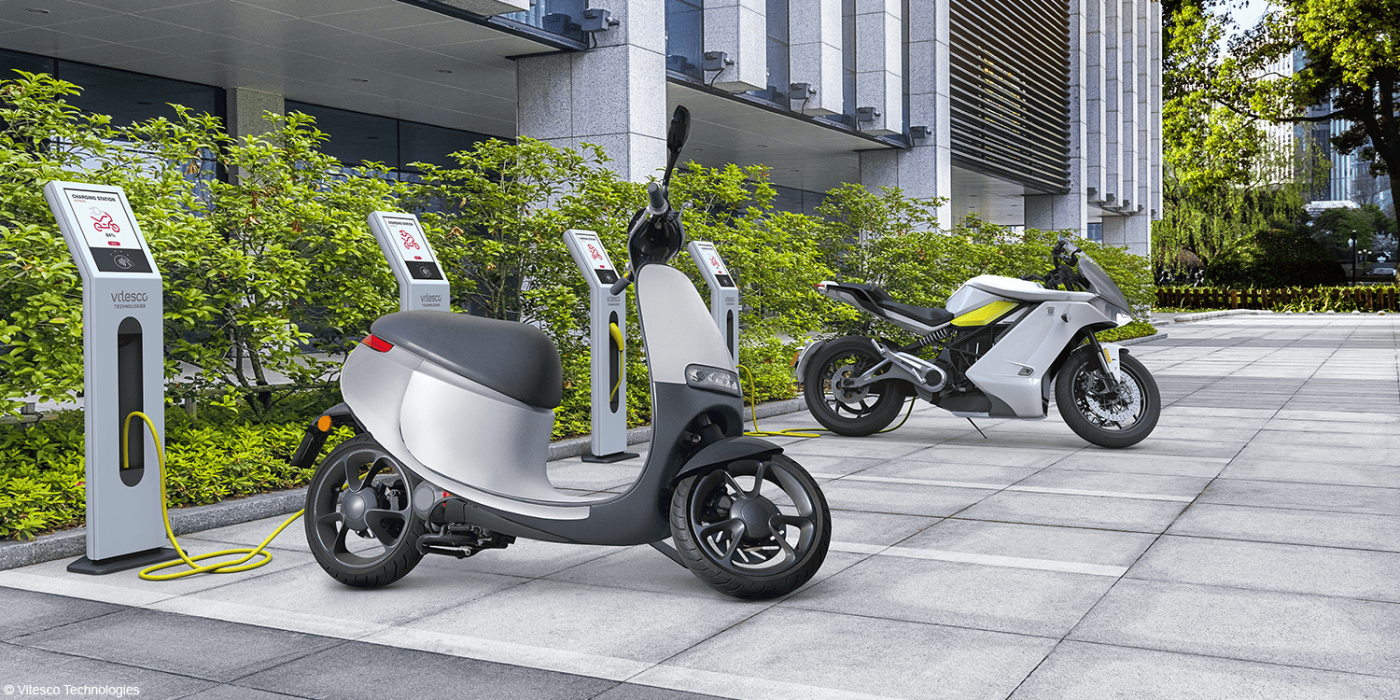Vitesco brings out e-motors for two wheelers
The German automotive supplier Vitesco Technologies has just presented system solutions for 48-volt electric drives for two-wheelers for the first time at the Milan motorbike trade fair EICMA 2021. A demonstration model of a hybrid motorbike will also be on display.
The 48-volt drives are designed for a power range of 3 to 7 kW and should correspond to combustion engines of up to 150 cc. These are therefore suitable for light motorbikes and electrically powered scooters. The drive system comprises an electric drive control unit (eDCU) with an integrated inverter and an electric motor with a special inductive rotor position sensor (iRPS). According to Vitesco, the latter is to ensure a “high control quality”.
With the drive, Vitesco is not only targeting electric mopeds in major European cities but also quite specifically customers in Asia. “Electrification is progressing, particularly in Asia, where motorized two-wheelers are almost a necessity for many people’s everyday mobility,” says Torsten Bellon, Head of Product Line Non-Automotive at Vitesco Technologies. “This trend is no longer limited to China, and the share of electric two-wheeled vehicles is increasing in countries such as India and Vietnam.” There are already the first customer projects for which the new drive is being developed for series use.
So far, mainly smaller two-wheelers with less than 3 kW power have been electrified – also because of the high battery costs, which would have made larger motorbikes with correspondingly more power and electricity requirements more expensive. According to Bellon, there is now an increasing trend towards electric motorcycles and more powerful moped scooters, which is also accelerated because of falling battery costs. “We expect the demand for electric two–wheelers with an output of 3 to 7 kW to increase sharply worldwide, including China, and that this market growth will take off sharply after a certain ‘tipping point’,” says the Vitesco manager.
In addition to the 48-volt drive, Vitesco is showing a hybrid drive for motorbikes at the world-renown motorbike show. According to the company, it assumes that for larger motorbikes “hybrid solutions will play an important role in a transitional phase – because…” and the argumentation is a little difficult to follow here: “… future CO2 limits can no longer be achieved by measures on the combustion engine alone”. Why the company has not gone for purely electric motorbike motors for larger bikes is not explained with this statement. Harley Davidson and Zero Motorcycles have had no such trouble electrifying larger bikes. Perhaps they are following the rather slow pace of famously conservative German companies like BMW, which, despite all indications that electrification is rolling forward at an unstoppable pace, have only just bought out an electric scooter in series production, while still failing to offer larger electric models.
While legacy motorbike makers in Europe seem to be having trouble moving with the times, disruptors are having no trouble picking up the slack. Also today, Niu just expanded beyond 48-volt models to reveal 73-volt models.
For their demonstrator hybrid, the German engineers at Vitesco have used a well-known component of a belt-driven 48-volt starter generator from the automotive sector. In the hybrid motorbike, the starter generator is intended to enable purely electric driving over shorter distances. A “very sophisticated control strategy” was developed. The Powertrain Domain Control Unit (PDCU) controls the 48-volt engine directly and communicates with the M4C engine control unit of the combustion engine – thus coordinating the two drives.
As with hybrid cars, the hybrid motorbike no longer shifts gears manually: Here, an “intelligent actuator” has been installed that can shift the transmission independently and without clutch actuation. If the control system can change gears “at an optimal time in terms of fuel economy”, Vitesco hopes for high CO2 savings – but it does not quantify these exactly.
The company has also recently agreed to a strategic partnership with GaN Systems to jointly develop GaN power semiconductor technology. GaN semiconductors are not based on silicon or silicon carbide, but on gallium nitride (GaN). GaN transistors can be smaller and more efficient – and, according to Vitesco, also more economical in system terms. With the partnership with the Canadian company, Vitesco wants to shorten the development time and open up “highly attractive automotive application fields”.
vitesco-technologies.com (48 volt) vitesco-technologies.com (demonstrator hybrid), vitesco-technologies.com (GaN partnership)





0 Comments